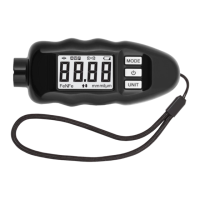
Do you have a question about the Carsys DPM-816 PRO and is the answer not in the manual?
| Brand | Carsys |
|---|---|
| Model | DPM-816 PRO |
| Category | Measuring Instruments |
| Language | English |
Details the functions of MODE, POWER, and UNIT buttons for device operation and calibration.
Explains the two primary methods used for measuring coating thickness on different substrates.
Emphasizes the need for initial calibration and explains the device power-on sequence.
Explains how to cycle through the five available operating modes (A, M, P, Fe, nFe).
Provides specific details on the Auto, Manufacturing, Program, and Ferrous modes.
Describes the Eddy current method for non-ferrous substrates and its usage.
Step-by-step guide for taking measurements in A, M, P, Fe, and nFe modes.
Explains why calibration is crucial and when it should be performed for optimal results.
Guidance on choosing suitable substrates for calibration and an overview of available calibration types.
Best practices for a clean calibration environment and scenarios requiring zero deviation calibration.
Detailed instructions on how to perform the one-point calibration procedure.
Step-by-step guide for performing the two-point calibration, including setting the zero and second points.
Procedures for measuring zero point and saving calibration data.